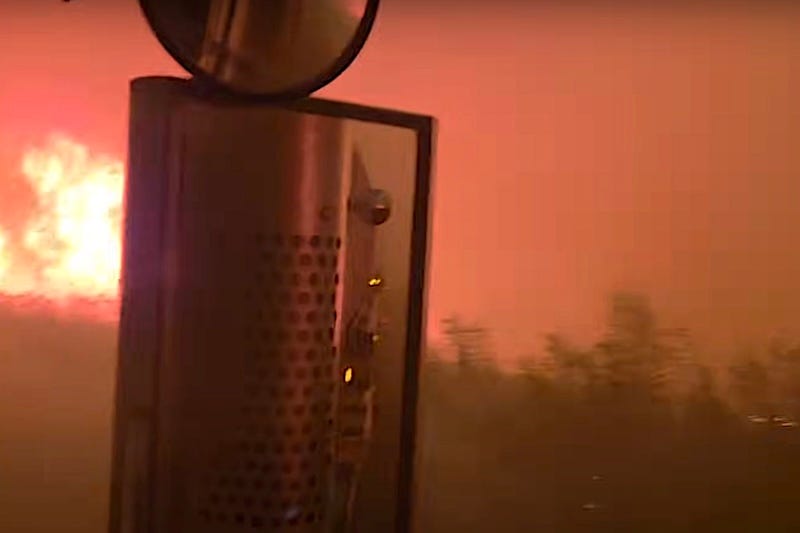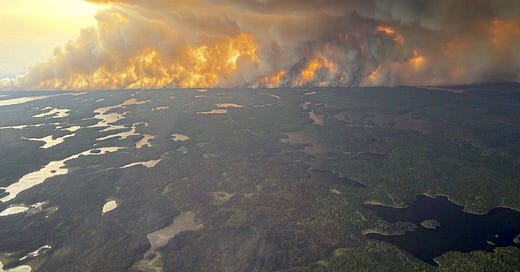June 5 was Environment Day. Ironically. And Manitoba is Burning.
Wildfire smoke is still deadly, even when you can afford three air purifiers for one home. Not everyone is so lucky. To stop the forests from burning each year, we have to stop burning fossil fuels.
Two years ago this weekend, we published a Weekender post titled Canada Burns. “When you can see climate change out your window and taste it in your throat, the crisis gets that much more visceral,” we wrote at the time. Now, right on cue, it’s happening again across Canada’s Western provinces.
And there’s something else that hasn’t changed. Just as the politics around the federal cap on oil and gas emissions provided the backdrop two years ago, the West is burning while the Carney government moves to fast-track approval of “national interest” projects that could pour fuel on the wider fire of carbon emissions and climate change.
So this week, we’re passing the mic to longtime Energy Mix friend and supporter Diane Beckett, who’s experiencing this year’s wildfire crisis from the ground up in Winnipeg.
It began in eastern Manitoba where towns, provincial parks, resorts, and lodges were evacuated, rural municipalities and roads were closed, at least one local state of emergency was declared, and two people died fire-related deaths. The first fire was reported on May 2, the situation escalated quickly, and fires are still burning there. On June 7, a fire covering approximately 203,720 hectares was still burning out of control.
Then northern Manitoba started burning. The earliest reported wildfire was May 25 and again the situation quickly escalated. More than 17,000 people were ordered evacuated from the north, and Premier Wab Kinew declared a provincial state of emergency on May 28.
As of Friday, about 733,820 hectares had burned in Manitoba so far this year, according to the Canadian Interagency Forest Fire Centre[MB1] , compared to 43,138 hectares on the same date in 2024.
On June 1, I woke up during the night with a terrible sore throat and feeling generally awful from wildfire smoke. I am about a two-hour drive from the fires in eastern Manitoba and a 10-hour drive from the ones in northern Manitoba. I looked at Environment Canada’s air quality index and it was 3.5. I checked the news, which reported it would be in the Very High Risk 10+ range that day.
The Finer Points of Air Purifiers
I bought a top-rated air purifier online in the middle of the night, to be picked up in the morning. I was so worried there would be no air purifiers left for me to buy in the morning. And I expected that if there were, that none of the good quality ones would be left. I imagined that I had been slow to react, and they would be sold out. I was so relieved.
I arrived home in the afternoon—after grocery shopping and picking up the air purifier—feeling miserable, light-headed, unstable, and with poor judgement from the poor air quality. The air quality was 10+ on Environment Canada’s scale.
I plugged in my new air purifier and a red light came on when the machine started up. That was the worst of the five colour zones on its scale. As the light turned green (blue being best), the air felt cool and clean. I felt myself recovering. But my body is still damaged from that short exposure.
And I was out with an N95 mask on. The problem is that it doesn’t fit me tightly. PPE is designed for men, while women are on the front lines of health. Under-protected. Because it’s 2025??
On June 5, Environment Day, the smoke was again awful in my home, and I felt it in my throat and in my eyes. My space is 200 square feet bigger than the recommended size for my air purifier, so the day before I had bought a smaller unit for my bedroom. That should have right-sized it.
But the smoke was so bad that the two machines couldn’t handle it. The reading inside my home was 18 units of PM2.5, the dangerous small particulates that lodge deep in the lungs and do lasting damage. That concentration falls at the midpoint on the Environment Canada scale, at the high end of moderate risk.
The World Health Organization (WHO) states that exposure over the course of a year should not be more than 5 units, and anything over 9 is harmful.
And so I bought another air purifier online early in the morning, rather than risk finding them sold out after the stores opened. I waited all day for my order to be filled, while the PM2.5 concentration in my home rose to 30 units, Environment Canada’s 10+ high-risk category. I put on an N95 mask inside my home with two air purifiers running. Near the end of the day, I was notified that the order wouldn’t be filled for 2.5 to three weeks. It was oversold.
There were four larger air purifiers at another store. There was one left when I got there, and I grabbed it along with some extra filters. The filters are supposed to last six months to a year. I doubt it, in these conditions.
My home is divided into two equal spaces of 350 square feet each. My living/dining room/kitchen has one air purifier that is meant to clean 625 square feet in 12.5 minutes, or 1,524 square feet in 30 minutes. After about an hour, it was still measuring 4 units of PM2.5—a safe level, but still an indication of how smoky it is outside.
Layers of Wildfire Impact
And with all of that, I know how lucky I am.
On June 6, Winnipeg had the worst air quality in Canada. But I have a home and can afford to buy three high-quality air purifiers, so I’m safe.
I can’t imagine waiting to be evacuated from northern Manitoba. Will the rescue come in time? Trying to decide which few items to take when evacuated on a small helicopter, how to survive financially after losing employment, potentially losing home, community—and, for Indigenous people, their land from time immemorial.
But the wildfires have affected me. I have a genetic heart condition, and I am supposed to avoid smoke (not to mention caffeine). In addition to the lung damage they cause, PM2.5 particles are so small that they can enter the bloodstream and cause heart disease and heart attacks.
Although any level of PM2.5 is unsafe, levels up to 9 are often generally considered safe, as the Environment Canada air quality scale indicates. However, the WHO has more on safe levels. The UN agency states that the annual mean PM2.5 exposure should not exceed 5 units, the 24-hour mean should not be more than 15 units, and that limit should not to be exceeded more than three to four times a year.
Health Canada says chronic PM2.5 chronic exposure at 10 units or higher leads to a corresponding 10% increase in the risk of premature death. The department estimates that air pollution already contributes to 15,300 deaths per year in Canada, with many more people losing days of work from asthma and acute respiratory problems.
Fires in Canada will only get worse until we burn all the forests, go over the tipping point into unstoppable climate chaos, or stop burning fossil fuels.
Video of the Week

Alberta’s Orphan Well Levy Is Unlawful, Insufficient, Coalition Contends
Hoping for ‘Decarbonized’ Oil Defies High School Chemistry, Climate Advisor Tells Carney
‘Desperate’ Pukatawagan Evacuation Continues as La Ronge Residents Ordered to Leave
B.C. Dismisses Pipeline, Carney Name-Checks CCS as First Ministers Heap Praise on PM
‘We’re Getting Desperate’: Chinook Helicopters En Route as 2,000 Stranded by Manitoba Wildfire
Evacuations Mount, Oil Sands Production Shut In as Heat Drives Early Prairie Wildfires
Top Free-Market Think Tank Unsure That Canada Needs More Pipelines
The Smoke From Canada’s Wildfires May Be Even More Toxic Than Usual
A National Grid Should Accelerate—Not Stifle—the Energy Transition
Climate policy is economic policy (The Hill Times)
The growth of U.S. solar manufacturing can’t keep pace with soaring demand (Corporate Knights)
Unusually low water in Yukon lakes this spring a sign of climate change (Canadian Broadcasting Corporation)
Arizona’s Water Is Vanishing Before AI Gets a Crack at It (Bloomberg)
Gila River Tribes Intend to Float Solar Panels on a Reservoir. Could the Technology Help the Colorado River? (Inside Climate News)
This Alberta solar field is now producing eggs (and honey, too) (Canadian Broadcasting Corporation)
Almost 40% of world’s glaciers already doomed due to climate crisis (The Guardian)
Heat is killing oil workers. The industry is trying to kill a rule for that. (E&E News/Politico)
Trump Administration to Open Alaska Wilderness to Drilling and Mining (New York Times)
China’s 1,000-Mile EVs Render Range Anxiety Obsolete (Bloomberg)
Chinese battery glut plugs into solar boom to power Pakistan (The Financial Times)
Penguin poop could be driving Antarctic cloud formation (Science)








Thinking of you, Diane, and the many people affected by wildfire smoke. It's been bad some days out east too. It's amazing and sad how quickly terrible wildfires have become the new norm.